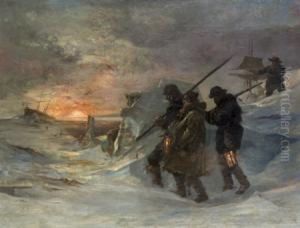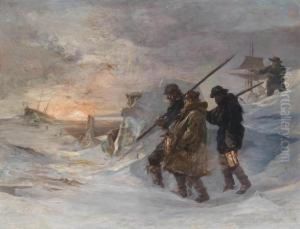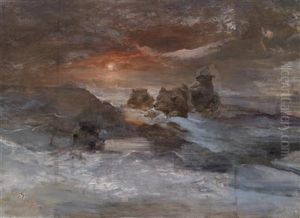Julius J.P. Payer Paintings
Julius Johann Ferdinand Payer was not primarily known as an artist, but rather as an Austro-Hungarian Arctic explorer, cartographer, and an officer in the Austro-Hungarian Navy. Born on September 2, 1841, in Schönau (now part of the Czech Republic), Payer attended military academies and served in the Austro-Hungarian Navy. His interest in polar exploration was kindled by the idea of discovering new territories and the challenge of navigating uncharted waters.
Payer's most notable contribution to exploration was his role as a co-leader of the Austro-Hungarian North Pole Expedition from 1872 to 1874, alongside Carl Weyprecht. The expedition aimed to explore the polar regions and to find a Northeast Passage. It resulted in the discovery of the archipelago Franz Josef Land in the Arctic Ocean, a significant geographical finding at that time. During this expedition, Payer made numerous sketches and paintings depicting the harsh Arctic landscape, which were later on used for cartographic and scientific purposes, as well as being of great interest to the public.
After retiring from his naval career, Payer focused more on his artistic pursuits. He studied painting in Vienna and Munich and became well known for his landscapes and scenes of Arctic life. His artwork served as a visual record of his adventures and was exhibited in various venues, contributing to the era's fascination with polar exploration.
Payer's passion for the Arctic continued throughout his life. He wrote several books about his experiences and lectures extensively. His artistic work is a lesser-known aspect of his legacy, overshadowed by his contributions to exploration, but it remains a valuable visual document of the environments and experiences faced by explorers during the Age of Discovery.
Julius Payer died on August 29, 1915, in Velden am Wörther See, Austria. His legacy is preserved in the maps and names of geographic features in the Arctic, as well as in the records and artistic depictions of the regions he explored. His works provide insight into the mindset and aesthetics of late 19th-century exploration and are a testament to the multifaceted nature of explorers of his time, who often combined scientific, military, and artistic skills to document and understand the world.


